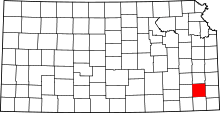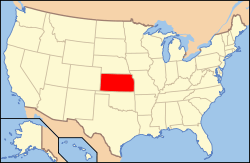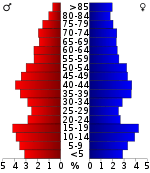Neosho County, Kansas
| Neosho County, Kansas | |
|---|---|
| County | |
 Location in the U.S. state of Kansas | |
 Kansas's location in the U.S. | |
| Founded | June 3, 1861 |
| Named for | Neosho River |
| Seat | Erie |
| Largest city | Chanute |
| Area | |
| • Total | 578 sq mi (1,497 km2) |
| • Land | 571 sq mi (1,479 km2) |
| • Water | 6.3 sq mi (16 km2), 1.1% |
| Population | |
| • (2010) | 16,512 |
| • Density | 29/sq mi (11/km²) |
| Congressional district | 2nd |
| Time zone | Central: UTC-6/-5 |
| Website |
NeoshoCountyKS |
Coordinates: 37°34′N 95°17′W / 37.567°N 95.283°W
Neosho County (standard abbreviation: NO) is a county located in the south east of the U.S. state of Kansas. As of the 2010 census, the county population was 16,512.[1] The county seat is Erie.[2]
History
Early history
For many millennia, the Great Plains of North America was inhabited by nomadic Native Americans. From the 16th century to 18th century, the Kingdom of France claimed ownership of large parts of North America. In 1762, after the French and Indian War, France secretly ceded New France to Spain, per the Treaty of Fontainebleau.
19th century
In 1802, Spain returned most of the land to France, but keeping title to about 7,500 square miles. In 1803, most of the land for modern day Kansas was acquired by the United States from France as part of the 828,000 square mile Louisiana Purchase for 2.83 cents per acre.
In 1854, the Kansas Territory was organized, then in 1861 Kansas became the 34th U.S. state. In 1861, Neosho County was established.
The first railroad was built through Neosho County in 1870.[3]
Geography
According to the U.S. Census Bureau, the county has a total area of 578 square miles (1,500 km2), of which 571 square miles (1,480 km2) is land and 6.3 square miles (16 km2) (1.1%) is water.[4]
Adjacent counties
- Allen County (north)
- Bourbon County (northeast)
- Crawford County (east)
- Labette County (south)
- Montgomery County (southwest)
- Wilson County (west)
- Woodson County (northwest)
Demographics
| Historical population | |||
|---|---|---|---|
| Census | Pop. | %± | |
| 1860 | 88 | — | |
| 1870 | 10,206 | 11,497.7% | |
| 1880 | 15,121 | 48.2% | |
| 1890 | 18,561 | 22.7% | |
| 1900 | 19,254 | 3.7% | |
| 1910 | 23,754 | 23.4% | |
| 1920 | 24,000 | 1.0% | |
| 1930 | 22,665 | −5.6% | |
| 1940 | 22,210 | −2.0% | |
| 1950 | 20,348 | −8.4% | |
| 1960 | 19,455 | −4.4% | |
| 1970 | 18,812 | −3.3% | |
| 1980 | 18,967 | 0.8% | |
| 1990 | 17,035 | −10.2% | |
| 2000 | 16,997 | −0.2% | |
| 2010 | 16,512 | −2.9% | |
| Est. 2015 | 16,346 | [5] | −1.0% |
| U.S. Decennial Census[6] 1790-1960[7] 1900-1990[8] 1990-2000[9] 2010-2013[1] | |||

As of the census[10] of 2000, there were 16,997 people, 6,739 households, and 4,683 families residing in the county. The population density was 30 people per square mile (11/km²). There were 7,461 housing units at an average density of 13 per square mile (5/km²). The racial makeup of the county was 94.90% White, 0.87% Black or African American, 0.98% Native American, 0.32% Asian, 0.02% Pacific Islander, 1.05% from other races, and 1.86% from two or more races. 2.91% of the population were Hispanic or Latino of any race.
There were 6,739 households out of which 31.50% had children under the age of 18 living with them, 57.40% were married couples living together, 8.50% had a female householder with no husband present, and 30.50% were non-families. 27.10% of all households were made up of individuals and 13.80% had someone living alone who was 65 years of age or older. The average household size was 2.45 and the average family size was 2.96.
In the county the population was spread out with 25.70% under the age of 18, 8.90% from 18 to 24, 25.40% from 25 to 44, 22.50% from 45 to 64, and 17.50% who were 65 years of age or older. The median age was 38 years. For every 100 females there were 93.40 males. For every 100 females age 18 and over, there were 91.10 males.
The median income for a household in the county was $32,167, and the median income for a family was $38,532. Males had a median income of $26,906 versus $19,387 for females. The per capita income for the county was $16,539. About 10.00% of families and 13.00% of the population were below the poverty line, including 17.60% of those under age 18 and 10.60% of those age 65 or over.
Law and government
Following amendment to the Kansas Constitution in 1986, the county remained a prohibition, or "dry", county until 1998, when voters approved the sale of alcoholic liquor by the individual drink with a 30% food sales requirement.[11]
Education
Unified school districts
- Erie-Galesburg USD 101 (Web site), serves the communities of Erie, Galesburg, Stark.
- Cherokee USD 247 (Web site), serves primarily portions of Crawford and Cherokee counties, but also includes small portions of Labette and Neosho counties.[12]
- Chanute USD 413 (Web site)
- Chetopa-St. Paul USD 505 (Web site)
- Cherryvale-Thayer USD 447 (Web site)
Communities

Cities
Unincorporated communities
- Kimball
- Leanna (on Allen County line)
- Morehead
- Odense
- Rollin
- Shaw
- South Mound
- Urbana
Townships
Neosho County is divided into twelve townships. The city of Chanute is considered governmentally independent and is excluded from the census figures for the townships. In the following table, the population center is the largest city (or cities) included in that township's population total, if it is of a significant size.
| Township | FIPS | Population center |
Population | Population density /km² (/sq mi) |
Land area km² (sq mi) | Water area km² (sq mi) | Water % | Geographic coordinates |
|---|---|---|---|---|---|---|---|---|
| Big Creek | 06675 | 456 | 4 (10) | 124 (48) | 1 (0) | 0.47% | 37°41′N 95°18′W / 37.683°N 95.300°W | |
| Canville | 10525 | 571 | 5 (12) | 124 (48) | 0 (0) | 0.34% | 37°36′N 95°27′W / 37.600°N 95.450°W | |
| Centerville | 12375 | 564 | 5 (12) | 123 (48) | 1 (0) | 0.93% | 37°31′N 95°18′W / 37.517°N 95.300°W | |
| Chetopa | 12975 | 894 | 7 (19) | 124 (48) | 0 (0) | 0.40% | 37°31′N 95°28′W / 37.517°N 95.467°W | |
| Erie | 21525 | 1,524 | 12 (32) | 123 (47) | 1 (1) | 1.17% | 37°35′N 95°16′W / 37.583°N 95.267°W | |
| Grant | 27800 | 384 | 3 (8) | 125 (48) | 0 (0) | 0.19% | 37°41′N 95°10′W / 37.683°N 95.167°W | |
| Ladore | 37600 | 401 | 3 (9) | 121 (47) | 3 (1) | 2.69% | 37°26′N 95°18′W / 37.433°N 95.300°W | |
| Lincoln | 40875 | 345 | 3 (7) | 123 (47) | 2 (1) | 1.29% | 37°26′N 95°9′W / 37.433°N 95.150°W | |
| Mission | 47250 | 927 | 8 (20) | 119 (46) | 5 (2) | 3.97% | 37°31′N 95°10′W / 37.517°N 95.167°W | |
| Shiloh | 65300 | 297 | 2 (6) | 125 (48) | 0 (0) | 0.25% | 37°26′N 95°28′W / 37.433°N 95.467°W | |
| Tioga | 70650 | 885 | 8 (21) | 109 (42) | 1 (1) | 1.21% | 37°42′N 95°27′W / 37.700°N 95.450°W | |
| Walnut Grove | 75175 | 338 | 3 (7) | 125 (48) | 0 (0) | 0.11% | 37°36′N 95°10′W / 37.600°N 95.167°W |
See also
|
|
References
- 1 2 "State & County QuickFacts". United States Census Bureau. Retrieved July 27, 2014.
- ↑ "Find a County". National Association of Counties. Retrieved 2011-06-07.
- ↑ Blackmar, Frank Wilson (1912). Kansas: A Cyclopedia of State History, Volume 2. Standard Publishing Company. p. 349.
- ↑ "US Gazetteer files: 2010, 2000, and 1990". United States Census Bureau. 2011-02-12. Retrieved 2011-04-23.
- ↑ "County Totals Dataset: Population, Population Change and Estimated Components of Population Change: April 1, 2010 to July 1, 2015". Retrieved July 2, 2016.
- ↑ "U.S. Decennial Census". United States Census Bureau. Retrieved July 27, 2014.
- ↑ "Historical Census Browser". University of Virginia Library. Retrieved July 27, 2014.
- ↑ "Population of Counties by Decennial Census: 1900 to 1990". United States Census Bureau. Retrieved July 27, 2014.
- ↑ "Census 2000 PHC-T-4. Ranking Tables for Counties: 1990 and 2000" (PDF). United States Census Bureau. Retrieved July 27, 2014.
- ↑ "American FactFinder". United States Census Bureau. Retrieved 2008-01-31.
- ↑ "Map of Wet and Dry Counties". Alcoholic Beverage Control, Kansas Department of Revenue. November 2006. Retrieved 2007-12-26.
- ↑ Burns, Tim (September 19, 2005). "Welcome To USD #247". Cherokee, USD 247. Retrieved 2007-01-23.
Further reading
- History of the State of Kansas; William G. Cutler; A.T. Andreas Publisher; 1883. (Online HTML eBook)
- Kansas : A Cyclopedia of State History, Embracing Events, Institutions, Industries, Counties, Cities, Towns, Prominent Persons, Etc; 3 Volumes; Frank W. Blackmar; Standard Publishing Co; 944 / 955 / 824 pages; 1912. (Volume1 - Download 54MB PDF eBook),(Volume2 - Download 53MB PDF eBook), (Volume3 - Download 33MB PDF eBook)
External links
| Wikimedia Commons has media related to Neosho County, Kansas. |
- County
- Maps
- Neosho County Maps: Current, Historic, KDOT
- Kansas Highway Maps: Current, Historic, KDOT
- Kansas Railroad Maps: Current, 1996, 1915, KDOT and Kansas Historical Society
 |
Woodson County | Allen County | Bourbon County |  |
| Wilson County | |
Crawford County | ||
| ||||
| | ||||
| Montgomery County | Labette County |
